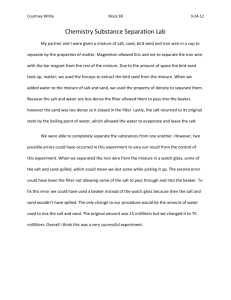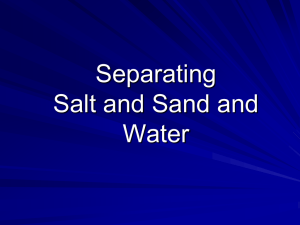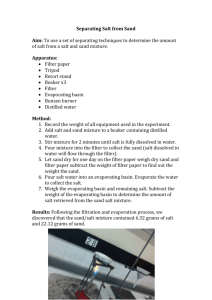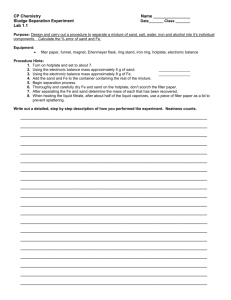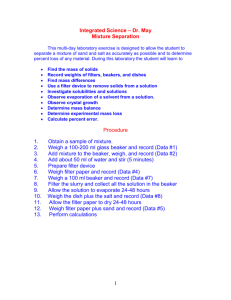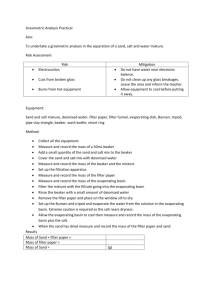Sand Salt Lab 2015
advertisement
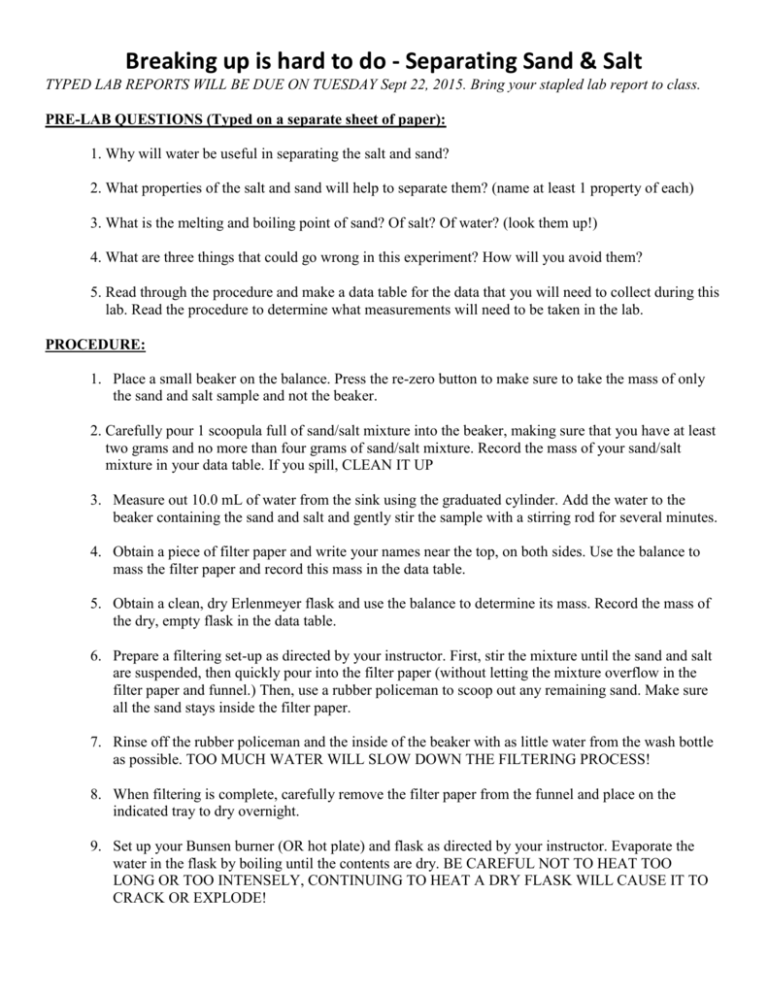
Breaking up is hard to do - Separating Sand & Salt TYPED LAB REPORTS WILL BE DUE ON TUESDAY Sept 22, 2015. Bring your stapled lab report to class. PRE-LAB QUESTIONS (Typed on a separate sheet of paper): 1. Why will water be useful in separating the salt and sand? 2. What properties of the salt and sand will help to separate them? (name at least 1 property of each) 3. What is the melting and boiling point of sand? Of salt? Of water? (look them up!) 4. What are three things that could go wrong in this experiment? How will you avoid them? 5. Read through the procedure and make a data table for the data that you will need to collect during this lab. Read the procedure to determine what measurements will need to be taken in the lab. PROCEDURE: 1. Place a small beaker on the balance. Press the re-zero button to make sure to take the mass of only the sand and salt sample and not the beaker. 2. Carefully pour 1 scoopula full of sand/salt mixture into the beaker, making sure that you have at least two grams and no more than four grams of sand/salt mixture. Record the mass of your sand/salt mixture in your data table. If you spill, CLEAN IT UP 3. Measure out 10.0 mL of water from the sink using the graduated cylinder. Add the water to the beaker containing the sand and salt and gently stir the sample with a stirring rod for several minutes. 4. Obtain a piece of filter paper and write your names near the top, on both sides. Use the balance to mass the filter paper and record this mass in the data table. 5. Obtain a clean, dry Erlenmeyer flask and use the balance to determine its mass. Record the mass of the dry, empty flask in the data table. 6. Prepare a filtering set-up as directed by your instructor. First, stir the mixture until the sand and salt are suspended, then quickly pour into the filter paper (without letting the mixture overflow in the filter paper and funnel.) Then, use a rubber policeman to scoop out any remaining sand. Make sure all the sand stays inside the filter paper. 7. Rinse off the rubber policeman and the inside of the beaker with as little water from the wash bottle as possible. TOO MUCH WATER WILL SLOW DOWN THE FILTERING PROCESS! 8. When filtering is complete, carefully remove the filter paper from the funnel and place on the indicated tray to dry overnight. 9. Set up your Bunsen burner (OR hot plate) and flask as directed by your instructor. Evaporate the water in the flask by boiling until the contents are dry. BE CAREFUL NOT TO HEAT TOO LONG OR TOO INTENSELY, CONTINUING TO HEAT A DRY FLASK WILL CAUSE IT TO CRACK OR EXPLODE! 10. When all the water has been evaporated, use the hot hands to place the hot flask on an insulator pad to cool. DO NOT PLACE HOT FLASK DIRECTLY ON THE COUNTER, IT WILL CRACK! 11. If time allows, use the balance to mass the cooled flask and its contents. If there is not enough time, leave a slip of paper with your names on it next to the cooling flask 12. You will mass the dried filter paper and sand on Monday. 13. BE SURE TO CLEAN UP YOUR LAB STATION BEFORE LEAVING DATA TABLE: (read the procedure to see what measurements you will need to take!) CALCULATIONS: show all work! 1. Mass of sand 2. Mass of salt 3. Percent sand 4. Percent salt POST-LAB QUESTIONS: 1. The sum of the percent salt and percent sand should theoretically equal 100%. Does your data reflect this? Why or why not? Explain. (SHOW ALL CALCULATIONS) 2. Which two separation techniques did you practice in this lab? Briefly describe each of them. 3. Explain how you would adapt your procedure in the future so that you could obtain a better percent yield and purer samples of the sand and salt. ***Remember....use your Lab Report Format sheet to help you write your lab reports! Be sure to includeall the required sections mentioned on the reference sheet! ***
